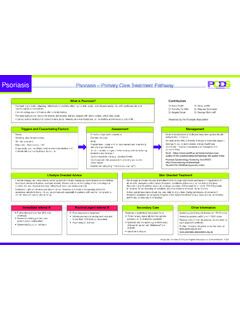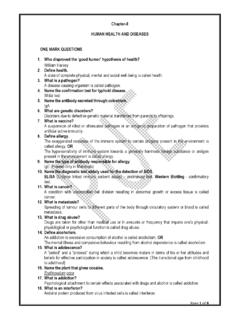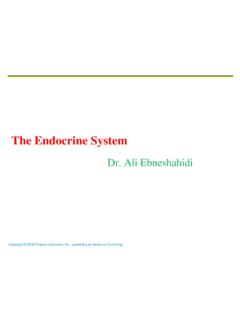Transcription of Acne Acne –Primary Care Treatment Pathway
1 Grading acne based on lesion type can help guide Treatment PCDS November 2015 Acne primary care Treatment PathwayAcneContributorsDr Tony BewleyConsultant DermatologistDr Chris BowerConsultant DermatologistDr Stephen Kownacki, GPDr Julian Peace, GPSIDr Angelika Razzaque, GPSIWhat is Acne?Acne, an inflammatory disorder of the sebaceous glands, is one of the most common dermatological disorders and is considered a chronic disease. Treatment may be required to improve both the physical appearance and prevent physical and psychological scarring. Whilst it is primarily a skin disorder of the young, often clearing up spontaneously, it can affect up to 12% of women and 3% of men over the age of 25. Treatment options for all age groups and both sexes are largely the same, apart from Hormonal therapyImportant Information About TreatmentsTreatments are effective but take time to work (typically up to eight weeks) and may irritate the skin, especially at the start of treatmentTopical and systemic antibiotics should not be prescribed together, or used as sole Treatment as bacterial resistance is a growing concernAll treatments should be routinely reviewed at 12 weeksIn the event of pregnancy, topical retinoids and oral tetracyclines should be discontinuedAt ReviewIf Treatment goals are reached at the 12 week review.
2 Maintenance therapy should be consideredDiscontinue topical/systemic antibioticsLegend+++ Strong recommendation ++ Moderate recommendation + Low recommendationTopical RetinoidTretinoin, Isotretinoin & Adapalene+++++++Benzoyl Peroxide (BPO)+++++++Azelaic Acid 20% Skinoren++++++Topical Antibiotics+++++Topical Retinoid/BPO Epiduo+++++++Topical Retinoid/Antibiotic CombinationTreclin++++++Topical Antibiotic/BPO CombinationDuac+++++Oral Antibiotics++++++++Combined Oral Contraceptives(for females only)++++++If Treatment goals are NOT reached at the 12 week review:Review adherence to Treatment (s)Consider alternative treatmentsRed FlagRefer immediately if:nSevere psychological distressnUncontrolled acne developing scarringnNodulo-cystic acne*nDiagnostic uncertaintynPatients failing to respond to multiple therapeutic interventionsTreatment graded by thepredominant presentComedonesPapulesPustulesNodules/C ysts**Nodules/CystsTreatment can be initiated, butpatients should be referredAcne Practical Advice and MaintenanceTop Tips and Myth BustingAcne is not caused by a poor diet.
3 However, the role of diet in acne remains controversialand a healthy diet is positively encouraged. There is some evidence that a high GI dietcan exacerbate hygiene is not a contributing factor to acne and aggressive washing is to bediscouraged. Patients with acne should be encouraged to wash no more than twice aday using gentle, fragrance free cleanser and dissuaded from picking and squeezingspots (pustules)Non comedogenic make up and emollients are recommendedAcne is not infectiousFurther information for healthcare professionals and patients can be found Advice1. Topical retinoidsshould be used for all grades of acne. Adapalene is better tolerated than other topical The irritant reactionwith topical retinoids and BPO can be ameliorated by gradual introduction by short contact initially and/or less frequent application.
4 Concurrent use with light non-comedogenic emollients may be Azelaic acidmay be beneficial in patients with darker skin where acne can lead to hyperpigmentation. 4. BPOcan cause bleaching of Oral antibiotics should not be used as sole should be prescribed with a topical retinoid and/or a BPO. Tetracyclines are first line and all show similar efficacy. Lymecycline and Doxycycline are likely to have better adherence due to their once daily dosage. Minocycline should not normally be used in view of higher risks. Erythromycin is second line (first line in pregnancy) due to high bacterial resistance. Trimethoprim is an option, but uncommonly used in primary Oral contraceptives:unopposed progesterones (including LARCS) can make acne worse. Second and third generation Combined Oral Contraceptives are generally preferred.
5 Co-cyprindiol (Dianette) is used in moderate to severe acne where other treatments have failed and discontinued three months after the acne has been controlled7. Combination Products:Combining topical treatments is recommended for most people with moderate acne (ref: NICE CKS). Combination products improve adherence. MaintenanceAs acne is a chronic condition it is advisable to use a topical retinoid for long termmaintenance. This may mean years. Occasional flares may require revisiting previouslysuccessful issue with antibiotic resistanceAnticomedonalIrritation can be a problemTreclinBroad spectrum of actionAnticomedonalAntibiotic resistance may limit theduration of treatmentDuacRapid onset of action on inflammatorylesionsTwo strengths availableNo action on comedonesThese comments are the opinions of the contributors, reviewed by the PCDS ExecutiveCommittee and do not consider NHS costs and local prescribing restrictions, if any.







